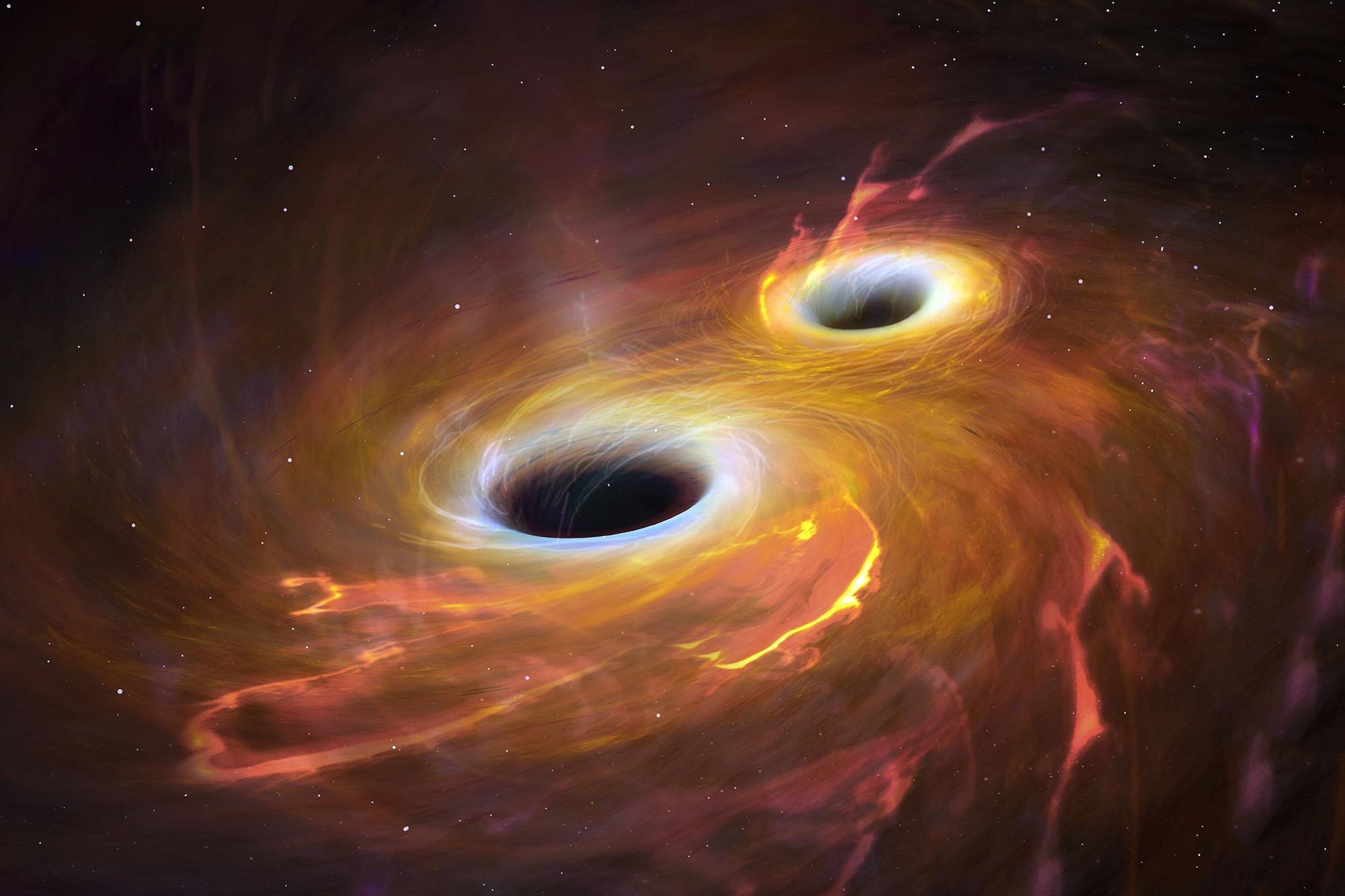Umělecký dojem dvou černých děr, které se chystají srazit.
Nová pozorování a analýzy odhalují dvě goliášské černé díry vzdálené od sebe pouze 750 světelných let a přibližující se, obíhající kolem sebe v důsledku splynutí galaxií.
Astronomové z Flatiron Institute a jejich kolegové objevili dva přízračné Goliáše na cestě na kataklyzmatické setkání. Astronomové to oznámili 9. ledna na setkání American Astronomical Society v Seattlu a v článku publikovaném v časopise Astrophysical Journal Letters.
Zatímco vesmírně blízko sebe supermasivní černé díry jsou jen 750 světelných let daleko, supermasivní černé díry se nesloučí až za pár set milionů let. Mezitím objev astronomů poskytuje lepší odhad toho, kolik supermasivních černých děr je také blízko ke srážce ve vesmíru.

Koncepce tohoto umělce ukazuje pozdní fázi galaktického sloučení a dvou nově objevených centrálních černých děr. Binární černé díry jsou nejblíže u sebe pozorované na více vlnových délkách. Kredit: ALMA (ESO/NAOJ/NRAO); Matka. Weiss (NRAO/AUI/NSF)
Tento vylepšený počet vrcholů pomůže vědcům naladit se na vesmírný sbor intenzivních vlnění v časoprostoru známého jako[{“ attribute=““>gravitational waves, the largest of which are products of supermassive black holes close to collision in the aftermath of galaxy mergers. Detecting that gravitational-wave background will improve estimates of how many galaxies have collided and merged in the universe’s history.
The short distance between the newly discovered black holes “is fairly close to the limit of what we can detect, which is why this is so exciting,” says study co-author Chiara Mingarelli, an associate research scientist at the Flatiron Institute’s Center for Computational Astrophysics in New York City.
Due to the small separation between the black holes, the astronomers could only differentiate between the two objects by combining many observations from seven telescopes, including NASA’s Hubble Space Telescope. (Although supermassive black holes aren’t directly visible through an optical telescope, they are surrounded by bright bunches of luminous stars and warm gas drawn in by their gravitational pull.)

Telescope observations of two newly discovered supermassive black holes on a collision course. Their host galaxy, left, is a mash-up of two galaxies that have collided. The pink box shows the location of the supermassive black holes. Close observation of the pair, right, reveals two distinct black holes (white spots) only 750 light-years apart. Credit: M.J. Koss et al.
The astronomers found the pair quickly once they started looking, which means that close-together supermassive black holes “are probably more common than we think, given that we found these two and we didn’t have to look very far to find them,” Mingarelli says.
The newly identified supermassive black holes inhabit a mash-up of two galaxies that collided around 480 million light-years away from Earth. Gargantuan black holes live in the heart of most galaxies, growing bigger by gobbling up surrounding gas, dust, stars, and even other black holes. The two supermassive black holes identified in this study are true heavyweights: They clock in at 200 million and 125 million times the mass of our sun.
The black holes met as their host galaxies smashed into each other. Eventually they will begin circling each other, with the orbit tightening as gas and stars pass between the two black holes and steal orbital energy. Ultimately the black holes will start producing gravitational waves far stronger than any that have previously been detected, before crashing into each other to form one jumbo-size black hole.
Koncepce tohoto umělce ukazuje pozdní fázi galaktického sloučení a dvou nově objevených centrálních černých děr. Binární černé díry jsou nejblíže u sebe pozorované na více vlnových délkách. kredit:[{“ attribute=““>ALMA (ESO/NAOJ/NRAO), M. Koss et al (Eureka Scientific), S. Dagnello (NRAO/AUI/NSF)
Prior observations of the merging galaxies saw only a single supermassive black hole: Because the two objects are so close together, scientists couldn’t definitively tell them apart using a single telescope. The new survey, led by Michael J. Koss of Eureka Scientific in Oakland, California, combined 12 observations made on seven telescopes on Earth and in orbit. Although no single observation was enough to confirm their existence, the combined data conclusively revealed two distinct black holes.
“It’s important that with all these different images, you get the same story — that there are two black holes,” says Mingarelli, when comparing this new multi-observation research with previous efforts. “This is where other studies [of close-proximity supermassive black holes] Padli do minulosti. Když je lidé následovali, ukázalo se, že existuje jen jedna černá díra. [This time we] Má mnoho poznámek, všechny ve shodě.

Schematické znázornění nejdůležitějších fází a kritických fyzikálních mechanismů řídících sloučení dvou supermasivních černých děr a odpovídajících reprezentativních časových a prostorových měřítek. Kredit: José Utreras/Ezequiel Treister, Centrum pro astrofyziku a přidružené technologie (CATA); Michael Koss (Eureka Scientific), a kol.
Ona a hostující vědec z Flatiron Institute Andrew Casey Clyde použili nová pozorování k odhadu vesmírné populace slučujících se supermasivních černých děr a zjistili, že „může být překvapivě vysoká,“ říká Mingarelli. Předpovídají množství párů supermasivních černých děr, které generují velké množství ultrasilných gravitačních vln. Veškerý ten ruch by měl mít za následek hlasité pozadí gravitačních vln, které je snazší detekovat, než kdyby byla populace menší. Vůbec první detekce chvění gravitačních vln na pozadí by mohla přijít „velmi brzy,“ říká Mingarelli.
Odkaz: „UGC 4211: Dvojitě aktivní galaktická jádra potvrzena v místním vesmíru při jaderné separaci 230 PS“ od Michaela J. Benny Trachtenbrot, Franz E. Bauer, Georges C. Brevon, Claudio Ricci, Richard Moshotsky, Loreto Barcus-Muñoz, Laura Plesha, Thomas Connor, Fiona Harrison, Tingting Liu, Macon Magno, Chiara MF Mingarelli, Francisco Mueller-Sanchez, Kyosuke Oh T. Taro Shimizu, Krista Lynne Smith, Daniel Stern, Miguel Parra Tello a C. Megan Urry 9. ledna 2023, k dispozici zde. Astrophysical Journal Letters.
DOI: 10.3847/2041-8213/aca8f0

„Unapologetický analytik. Rozzuřeně skromný kávový evangelista. Hráč. Nelze psát s boxerskými rukavicemi. Student. Podnikatel.“
You may also like
-
Astronauti NASA Butch Wilmore a Sonny Williams přilétají na Floridu prvním pilotovaným vesmírným letem Boeingu.
-
Na nových satelitních snímcích byly v tajemném „městě Inků“ na Marsu spatřeny stovky černých „pavouků“.
-
Naléhavé varování pro 23letou ženu, která je paralyzována zbytky polévky
-
Možná jsme zaznamenali první magnetickou erupci mimo naši galaxii
-
Propuknutí ptačí chřipky u hospodářských zvířat mohlo začít o měsíce dříve, než se myslelo

